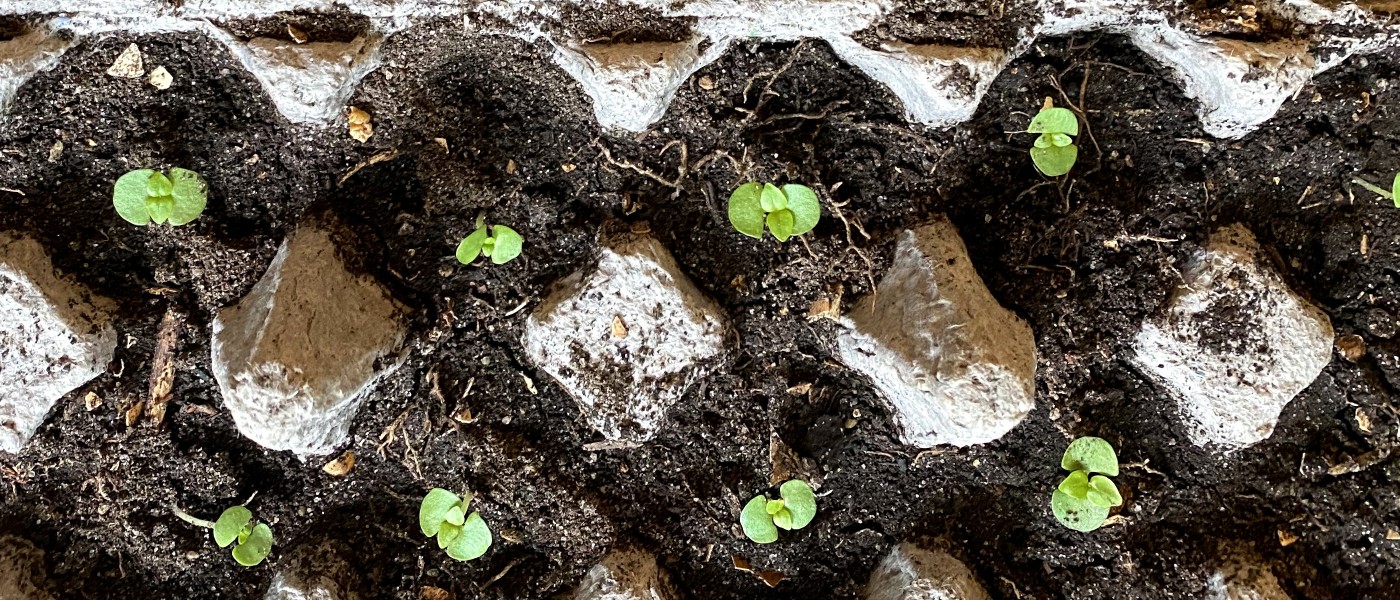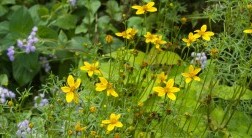My backyard, a typical Brooklyn brownstone garden, has a mixture of in-ground and container plantings, and limited hours of daily sun. I quit trying to grow sun-loving tomatoes years ago but have had great success with culinary herbs.
Being able to step just outside your kitchen to snip a fresh sprig of mint for your julep, grab a handful of chives to garnish an omelet, or pinch a bit of thyme to season some pasta sauce is every home cook’s dream. If you’ve got access to an outdoor space with some direct sunlight you can make that dream come true. Here's how to start a small garden from scratch or expand from established plants.
Assessing Your Space
Gardening on a small scale allows you the freedom to experiment with plant placement. Even within a 750-square-foot brownstone garden, there are dozens of microclimates—small pockets with different environmental conditions. A basil plant in one location may grow much better than another placed just a few feet away. Neighboring buildings, fences, and trees or large shrubs may block sunlight from reaching parts of your garden but may also provide some protection from winter winds.
It is well worth spending a few days observing how the sun passes over your garden space before you start buying and planting. If you discover a particular herb isn’t doing so well in one location, try digging it up and replanting it somewhere else.
For example, in my garden, I have rosemary and sage plants (both native to a Mediterranean-type climate) in large planters that I move to the middle of my patio during the summer to optimize hours of sunlight. Then I tuck them into a brick-walled corner to overwinter, which shelters them from cold winds and also lets them take advantage of some solar heat gain absorbed by the bricks. On the other hand, my thyme, which can tolerate colder winters, grows just fine in-ground.
Choosing your Herbs
Most herbs are commonly available at farmers’ markets and local nurseries. You could start each growing season with a whole new batch, not worrying about winters, and treating each plant like an annual. But there is something delightful about tending a perennial garden, and that is always my first choice. Kitchen stalwarts basil and parsley are the exceptions, though, and I either start them from seed or purchase seedlings every year.
Every plant listed below can be grown in a container or in the ground. Most herbs love full sun, defined as at least six hours of direct light per day, but I have grown all of the herbs below in part-sun conditions of 4–6 hours.
Peppermint and Spearmint (Full Sun to Part Shade)
Peppermint (Mentha x piperita) and spearmint (Mentha spicata) are vigorous growers so I prefer to confine them to a container. They will die back in the winter and when they get going again in the spring, you’ll see that they have grown out to the edges, creating a barren center. I dig them out each spring, divide, and replant. If you grow mint in ground, it will likely spread. Every spring you can divide sections to give away.
Sage (Full Sun)
Sage (Salvia officinalis) is a woody perennial that will survive most of our NYC winters. I grow mine in a container that I move to a sheltered space during the coldest months. In the spring, I snip out any dead branches, and cut healthy ones above a node where new leaves are developing.
Rosemary (Full Sun)
Rosemary (Salvia rosemarinus) is a sun-loving woody perennial that will not survive particularly cold winters. If it does, though, spring care is simply snipping out any dead sprigs. I also like to harvest a few of the taller living stems by cutting above a node where new leaves are developing.
Thyme (Full Sun)
Woody, mounding perennial thyme (Thymus vulgaris) likes well-drained soil and is well-suited to a rock garden setting. It overwinters easily and can take a bit of gentle winter harvesting. Old stems start amassing below newer, leafier ones—clip out some of those woody stems early each spring to make room for new growth.
Oregano (Full Sun)
Oregano (Origanum vulgare) grows rapidly and spreads horizontally, providing continual opportunities for harvesting all summer long up until a hard frost. (It also creates a nice cascading effect in a planter.) If you’re growing for culinary purposes, cut the entire plant back to 3–4 inches in early spring to force new, more tender and flavorful growth.
Chives (Full Sun to Part Sun)
Chives (Allium schoenoprasum) die back and overwinter underground. They’re one of the earliest perennial plants to poke above ground in spring, and I look forward to my first bagel with cream cheese and fresh chives every March.
Sorrel (Full Sun to Part Sun)
Lemony leafy sorrel (Rumex acetosa) is another reliable perennial that I start harvesting in March. It is a vigorous grower and should be divided each spring to maintain its size and flavor.
Parsley (Full Sun to Part Sun)
Parsley (Petroselenum crispum) is an easy-to-find annual plant. You can also encourage yours to flower and set seed in late summer and enjoy self-sown parsley the next spring. Parsley plants also sometimes survive mild winters like the one we just had, but will be relatively short-lived since they are biennials (plants with two-year lifecycles.)
Sweet Fennel (Full Sun to Part Sun)
This fennel (Foeniculum vulgare) is grown for its licorice-flavored foliage (versus the variety grown for the bulb-like vegetable) as well as its fragrant seeds. It’s a tender perennial that I leave in my garden through the winter, cutting the old stalks down in early spring. If you don’t like how that looks, cut it down to a couple of inches in late fall, after harvesting some of the dried seeds and perhaps shaking some on the ground to await the next season.
Basil (Full Sun to Part Sun)
Basil (Ocimum basilicum) is the least cold-tolerant herb on this list and should be planted as an annual no sooner than mid-May. It is easy to find basil seedlings for sale, but also easy and very rewarding to start from seed yourself, indoors, in early April.
To Flower or Not to Flower
The culinarily desirable part of herbs is primarily their leaves. By harvesting throughout the growing season, the herb gardener forces plants to continually produce new leaves. At the same time, that gardener is preventing the plant from flowering, which would divert energy away from leaf production, resulting in fewer tasty leaves for the kitchen table.
However, there are times when you might want to encourage flowers. For plants that have annual life cycles in our climate, such as basil and parsley (or that produce culinarily desirable seeds in the case of sweet fennel), allowing the plant to develop flowers toward the end of the growing season will lead to seeds that you can collect and save.
Once the flowering stalks have dried and turned brown, snip them off and roll the tiny, dry fruits between your fingers over a clean sheet of light-colored paper until the seeds fall out. Store the seeds in marked envelopes indoors over the winter.
Starting Seeds Indoors
Basil lends itself more easily to indoor seed starting than most herbs and is a good one to start with. In early April, you can plant seeds, either those you collected from your plants the previous year or some that you've purchased. Use a shallow plastic tray with drainage holes or make your own seedling tray out of cardboard egg cartons. Plant two seeds per section in potting soil and water so the soil is evenly moist. The cardboard version will let more moisture evaporate than the plastic tray, so will require more frequent watering.
Place the planters in a very sunny window, or under a grow light or florescent lightbulb. If you are using lights, ideally these should be placed about 6 inches above the plants and kept on a 16-hours-on/8-hours-off cycle.
If both seeds sprout, use a pair of nail scissors to snip one out, giving the remaining one adequate space. Once your basil seedlings have about four sets of leaves, you can pinch them back by snipping the stem under the top pair of leaves. This will encourage the plant to bush out—sending new branches out from the node right under the cut stem.
About two weeks before planting time (for basil in NYC, this is typically the middle of May), you can start hardening off your seedlings to get them accustomed to outdoor conditions. Start for a couple of hours on an overcast day, or by placing them in a shady spot, and gradually increase both the amount of time and the intensity of sunlight. Choosing an overcast day to transplant your seedlings outdoors makes the permanent transition less stressful. As with any time you transplant a plant, make sure to water it in well, to ensure the soil is snug around the roots.
Sharing the Bounty
Herbs are wonderful to share with friends, neighbors, schools, and community gardens, and there a couple of easy ways to safely separate your plants in order to pass them along.
Dividing
Mint, chives, and sorrel can be divided in early spring (March in NYC). Dividing is simply slicing the entire plant, including the root zone, into pieces. You can use a hand trowel to divide smaller plants, while a sharp-edged shovel and a strong leg work for larger ones.
Layering
Rosemary, sage, mint, oregano, and thyme can be layered any time during the growing season to create a new plant. Layering is a two-step process. First, find a section of stem that you can lay out on top of the soil. Use a rock or a metal stake to pin the stem so it remains in contact with the soil. Next, wait. The stem will start to grow roots down into the soil. Once the roots are established, you can cut the stem and remove the section of the plant that can now stand alone—roots, stem, and leaves—and be replanted somewhere else.



